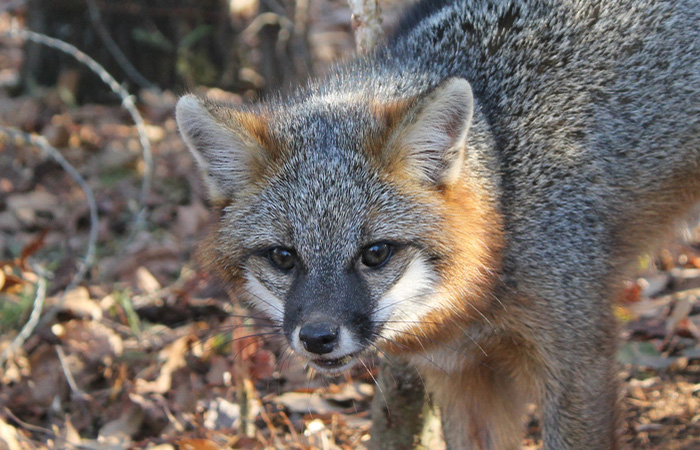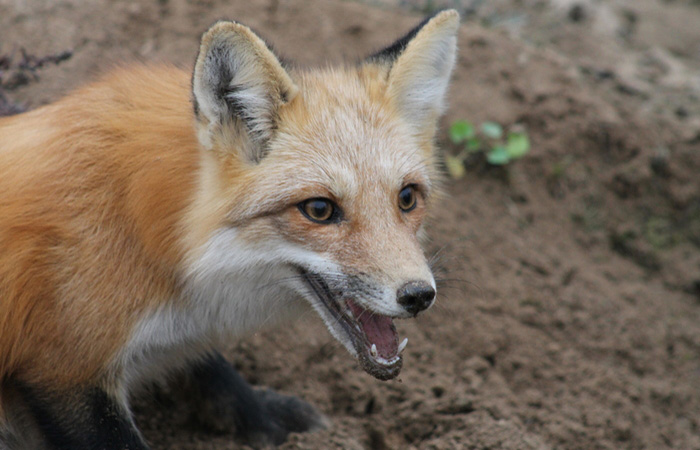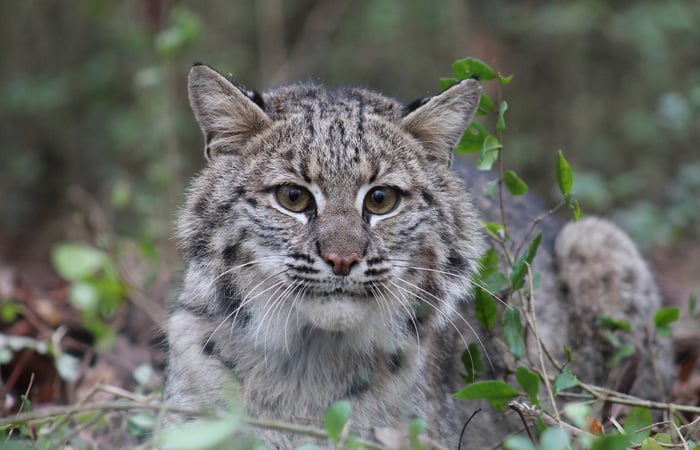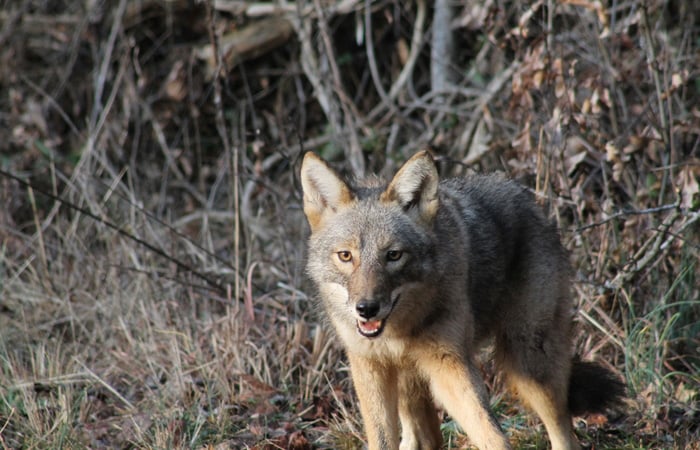
Last Updated on
By Pete Rogers
My distressed cottontail mouth call carried in the predawn morning. Frost covered the winter grazing grounds that stretched out before me. After a few minutes of calling, I settled in to watch and look for movement. At a little over two hundred yards the red fox appeared from behind some hay bales trotting directly towards me. Settling in on my shooting sticks, I waited for the beautiful red to get into a more comfortable range. The morning light cascading across his fur as his head looked side to side. A few lip squeaks confirmed his enthusiasm, as he made it to thirty yards the report from the Marlin 983T ended the hunt.
This hunt was focused on the fox that seemed to overpopulate the farm. The vantage called for shots inside one hundred yards so I opted for the Marlin 893T in .22 Win. Mag. This powerful rimfire is my preferred weapon for fox that seldom top ten pounds. The magnum rimfire loaded with either the 30 or 33 grain ballistic tip is in my estimation the perfect combination for fox – that is if you are wanting to save the fur, and shots are inside one hundred yards. For longer ranges the flatter and fast flying .17 HMR is also a great option for these small predators. This destructive little cartridge has gained a lot of popularity in recent years. More and more varmint and predators hunters are finding this little gun the perfect choice for the smaller predators and varmints. While many predator hunters never think of rimfire rifles for predators, matching the gun and ammunition to the size of the animal and the conditions only makes sense.
For challenge and fun, it’s hard to beat the excitement of calling predators. Setting up and calling coyotes, fox, and bobcats is exciting, challenging, and rewarding. An added bonus to hunting these predators is their fur is still marketable when handled correctly.
There is definitely some commonality to calling and killing different predators. Keying in on their territorial instinct, their need for food, will work for almost all. But knowing the differences between the different species can help you if you are targeting a specific species.
First and foremost, get knowledge of your local game laws about seasons, weapons, night hunting and whether the use of electronic calls are legal. Here in South Carolina, as well as other states, the use of electronic calls and night hunting is restricted for coyotes only. This can pose a bit of a problem for some, because by law, if you are using an electronic call for coyotes and a grey fox comes bounding in, you cannot kill it. Same is true for bobcats and raccoons. Coyotes are the only predators that may be hunted with electronic calls or at night. Other states allow the use of electronic calls for all predators. The same can be said about hunting after sunset. Some states allow hunting predators at night, while others do not. Those that do allow hunting them at night have restrictions of weapon choices, lights, intensity of lights, use of night vision equipment etc. Just check your game laws to make sure you are legal.
With these things in mind, let’s look at the different species and how to successfully kill them consistently.
Fox
Hunting fox both grey and red has lost some popularity over the past few decades. In the south fox hunting used to mean following dogs across hill and dale for half of the night in hopes of getting a good chase. Those days are long gone in the modern south, and predator hunters have filled the void of chasing fox with hounds to calling these predator into gun range.
The first twenty years of my predator hunting career consisted of calling fox and bobcats. My native state of South Carolina was absent of coyotes. But the predator hunter in me was developing among the dairy and poultry farms I grew up around. These farms had an abundance of fox, and they were willing farmers to allow me to help rid them of these predators. For beginners in the world of predator hunting, fox is a great way to get your feet wet. They are quick to respond and willing to commit. Weapon choices are wide for this diminutive predator. The rimfire magnums mentioned earlier are excellent choices. For those in more thick cover, the 12 gauge shotgun loaded with some #5 shot is almost perfect. I have killed a lot more fox with the scattergun than with rifles, and shotguns in 12, 16 and 20 are all acceptable for fox when loaded with the right shells. As the gauge gets smaller, up the shot, # 1 buck in the 20 gauge is excellent choice.
Common distress calls are all that’s needed for the opportune predator. Cottontail distress, woodpecker distress and a few lip squeaks will usually bring in any fox within earshot. If they are around, they will respond and usually quickly. Farm country usually holds more red fox who prefer more open terrain. These are my personal favorite. The beautiful red with his black boots makes a fine trophy for any predator hunter. A bit more shy than his cousin the grey, few animals match him for overall beauty. Some stands to look in farm country include abandoned farm machinery, hay bales, field barns, and fence lines. Most farms have miles of fence and setting against a fence post is always food cover for fox. Near poultry farms, distressed chicken sounds will put them directly in your lap a lot more often than one would expect.
Grey fox prefer more wooded areas, and these largely nocturnal feeders are aggressive and willingly commit to what sounds like an easy meal. Overgrown fields, riparian zones, tree lines through fields, and woodlots are all favorite locals for Grey fox. Outside the locations, calling fox is about the same, and since their territories often overlap, I use the same calls for each. It’s not that uncommon to get a double of different species at the same stand. I tend to opt for the shotgun when hunting grey’s because of the terrain. More wooded areas can also mean closer and moving shots.
Bobcats
Bobcats are some of the most difficult of all predators to call to the gun. They are shy, cautious and slow to respond to the call. More than with fox, a moving decoy will help distract the cats and get them to commit a bit quicker. While there are a lot of great decoys out there, the Mojo Critter is an excellent choice for bobcats. However in a pinch, hanging a turkey wing feather from a limb will also work. These feathers will spin and twirl with the slightest breeze and give a visual attraction for cats.
When calling cats, I start with small mouse squeaks, and ratchet up to bird distress sounds. Normally, I stay with these until I get a response or decide to move on. Cats are visual hunters and will key in on the decoy but are still slow to commit. I have seen many times a cat start coming at a distance, look right at the decoy and sit down looking directly at the decoy or call and not move for fifteen minutes. In these situations its best to have a rifle that can reach out there and get them.
Bobcats can get up to thirty or thirty five pounds with a few getting heavier, the centerfire .22’s are the best choice for a variety of reasons. My personal favorite is the .22-250 loaded with a 55 grain ballistic tip bullet. This tiny centerfire can kill cats further than I can see them so any hesitant cat has little opportunity to escape.
While bobcats prefer thicker terrain, it is pretty easy to call them out into the open. They will not commit as easy, but they will expose themselves and give you an opportunity. Here again, if you are hunting near rivers, riparian zones, and field edges, a shotgun can be a great choice. Of the hundreds of bobcats I have called into the gun, a full zero came in fast, running, or trotting. One hundred percent came slow, cautious and sneaking into range. Calling sequences will last a lot longer if you believe cats are in the area. I will normally give the area at least forty five minutes before I make a move. Calling for two to three minutes, a minute pause, another two to three minutes and a minute pause and continue this for the full stand.
The .22-250, .204 Ruger and the .223 are the overwhelming favorite calibers for predator hunters. Personal preference here pretty much dictates the choice. All are more than capable of killing predators at extreme long ranges. They are light, low recoil and easy to shoot. They all come in a variety of actions and styles for all preferences.
Coyotes
The coyote is without a doubt the apex predator in states that are absent of lion or wolves. Calling in and killing a coyote is a great thrill and experience. Regardless of what you may think, all areas of our states have a very healthy population of coyotes, and killing them will definitely help your confidence as a hunter, and will help your deer herds. Where legal, I prefer to use a combination of electronic calls and hand calls. Using the electronic calls for volume and to reach out and touch them, hand calls when it gets closer.
When calling coyotes, I like to use the analogy that trout anglers use. Match the hatch – look what the coyotes are feeding on and use that sound. If hunting near poultry farms, a distress chicken will put them in your lap. But if you are miles from poultry farms, stick with rabbit, bird and the like to call coyotes. As the breeding season rolls around, usually between January and March, howls and barks can also bring in coyotes. Late winter is also a great time for pup in distress calls.
While they often will not respond as quickly as fox, they seldom take as long as bobcats. A normal stand will start with an electronic call and a howl to see if there are any interested. Usually if I get an answer from a howl, I think I can call that coyote to me. Then setting up, I will go with a distress sound (again matching the hatch) rabbit, chicken, goat, bird or even go straight to the distress puppy sounds. Call for a minute, sit for two, and repeat. If a dog hasn’t responded within thirty minutes, I get up and move a quarter mile and repeat.
Calling coyotes, bobcats or fox is a great thrill, and having predators come into your calls will definitely make you a better hunter. But there is a lot more to it than sitting down and pushing play on a digital caller. Scouting, set up, playing the wind, weather patterns and camouflage all are important aspects to effective predator calling.
Scouting And Night Hunting Tactics
As with all hunting scouting is critical. Regardless of how good of a caller you are, if there are no predators there, you will not be able to call them in. Find tracks, scat or actual sightings and you will be off to a good start. Set with the sun at your back and sit in the shadows. It is really amazing how well this works. Lastly, have good camouflage from head to toe and make sure you carry some sort of shooting support. Sticks, bi-pod, something to rest your gun on for those longer shots. As stated earlier a fox is a small animal and trying to hit a kill zone the size of a baseball at one hundred and fifty yards is not as easy as we like to think.
Lastly, where legal if you have the opportunity to hunt these predators at night, you need to give it a try. Today there are excellent choices of night vision optics available as well as great spotlights that allow hunters to pierce the dark and increase their odds at killing these predators.
When hunting at night with spotlights it is a lot easier if you do so in a team. One person working the light and another shooting is the best way to structure it. The light person should be careful not to hit the animal directly with the light but carry them in the edge of the beam. Most will not pay the light any attention unless it hits them directly. Some hunters like to use a red filter on the light, and it works great but limits the range of the light beam. All other techniques mentioned are the same. The biggest difference is that the predators tend to respond a lot quicker and with less hesitation after the sun sets.
If using night vision there are really two options: thermal and infrared. Thermal picks up on the temperature of the animal and the animal emits a white glow in the optics. This makes them very easy to see and to shoot. Infrared on the other hand literally pierces the dark and returns a green image of everything out there. I have used both to a limited degree and really have not found a preference. I like the thermal for longer range and it does not mistake a bush for an animal. Everything emitting heat will glow, from mice to men. Whereas the infrared will be like daylight only with a green hue.
Many manufactures offer infrared scopes or additions to scopes to convert current scopes to night vision. Thermal image equipment is a bit more specialized. Either one you choose will increase your odds in killing predators at night.
Hunting predators, whether during the day or night, is great fun and challenging. If you like to hunt, you will love hunting predators. Calling in a beautiful red fox or bobcat is often the highlight of the season for beginners. Others successfully call in and kill dozens of each. As is the case in most areas, predators are also listed as furbearers and the limits are pretty liberal if they exist at all. Check your local wildlife agencies for seasons and limits.








Leave a Reply